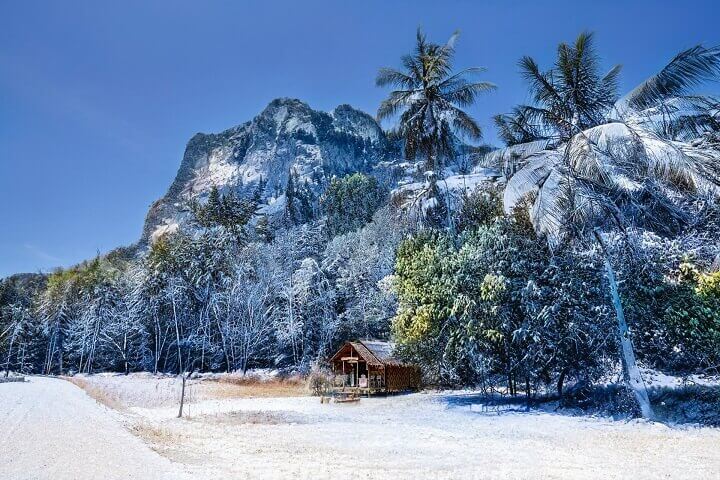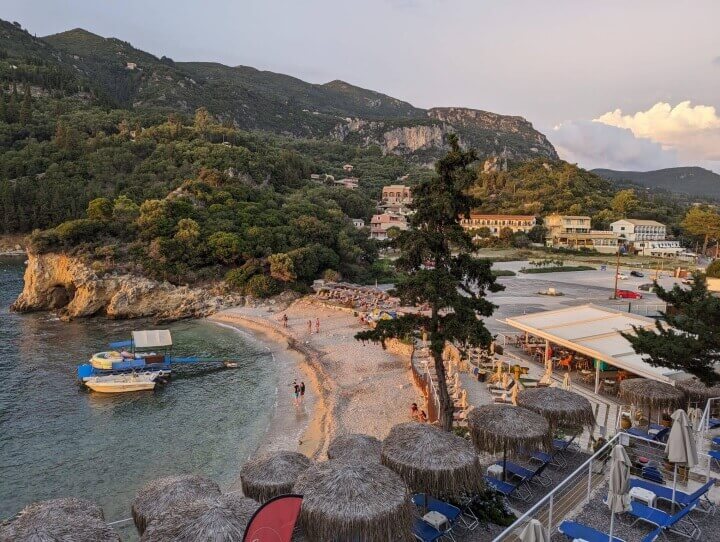Does It Snow in Thailand? Everything You Need to Know
Thailand is a popular travel destination, famous for its beaches, delicious food and fascinating culture. If you’re trying to decide on the best time to visit, you might wonder, “Does it snow in Thailand?”
This guide to winter in Thailand will provide all the information you need. You will understand how Thai seasons work and ultimately determine the best time to go to make the most of what this beautiful country offers.
I have travelled to Thailand during the winter season and can confirm that it is an excellent time to visit. In short, it doesn’t snow in Thailand, and its winter is quite different from what many people in Europe and North America are accustomed to.
Let’s delve into the details of Thai winter and explain why you won’t need to worry about snow, regardless of which part of the country you’re in.
Disclosure: Some of the links below are affiliate links, which means that at no additional cost to you, I may earn a small commission if you click through and make a purchase. Please note, I only recommend products and services that I know and love. Read full Privacy Policy here.
Does it Snow in Thailand?
No, it does not normally snow in Thailand. The reason lies in its tropical climate, with average temperatures ranging from 18 to 38°C (64 – 100°F) depending on the season.
For snow to form and remain on the ground, temperatures must dip below 2°C (35.6°F). In other words, it is simply too hot for snow in Thailand.
You might be wondering about the photo of snow in Krabi above. Don’t worry, it’s not real.
So, if you’re fond of snowy winters, Thailand might not be the right destination for you. But if you’d like to swap snow for sunshine and warmth, Thailand is a perfect choice.
Has Thailand Ever Had Snow?
Although it doesn’t normally snow in Thailand, there has been an exception. On the 7th of January 1955, Chiang Rai, Thailand’s northernmost province, experienced a brief snowfall. The snow remained on the ground for 14 hours before melting.
This event remains the only documented instance of snowfall in Thailand. However, it wasn’t the kind of winter snowfall familiar to those in Europe or North America. Instead, it was made up of hailstones which are not uncommon in the mountainous parts of northern Thailand.
So, while you might encounter hailstorms when traveling in northern Thailand, witnessing actual snow in the country is extremely rare.
Does Thailand Have Winter?
Although it doesn’t snow in Thailand, the country does technically have a winter season spanning from November to February. This period is often referred to as the cool season. During these months you will find that the days are hot and pleasant, but the heat is not as intense as during other times of the year.
The average “winter” temperatures in Thailand typically range between 28°C and 33°C (82°F to 91°F). It is also the driest period, with relatively low humidity for the tropics.
The cool season is considered the best times to visit Thailand. The heat and humidity are still comfortable. This is an ideal time to really explore the country, both its cities and beautiful nature.
How Many Seasons Are There in Thailand?
Thailand doesn’t experience the four distinct seasons that travellers from Europe and North America are accustomed to. Instead, its weather is defined by three: the cool season, the hot season and the wet season.
As previously mentioned, the cool “winter” season runs from November to February. It is followed by the hot season that lasts from March to May. April tends to be the hottest month when average temperatures exceed 30°C (86°F).
During the wet season that runs between June and October, the country sees heavy rainfall and even occasional typhoons. Rain normally manifests in short intense showers in the afternoon or overnight. September and October see the heaviest rainfall.
Although the wet season is not the hottest, its high humidity can make outdoor activities less comfortable.
When Is the Best Time to Travel to Thailand?
The best time to travel to Thailand is during the cool season, from November to February. During this period, temperatures are pleasant, humidity is low, and rain is less likely to disrupt your travel plans.
However, the cool season in Thailand is also the high season, which means larger crowds and higher flight and accommodation prices. Nevertheless, there’s still great value to be had and lesser-known spots to explore. You just need to do your research and book everything in advance.
As an alternative, March and early April also offer sunny days and a low chance of rainfall. Crowds should also subside a little by then. However, late April may feel unbearably hot and humid which would make active exploration less pleasant.
Another time worth considering is late October. It is the last month of the wet season, so the weather is still unpredictable. However, at the end of the month dry sunny days become more common. This is when you’re likely to enjoy decent weather without the crowds and the high season price tag.
It is also worth remembering that due to Thailand’s size, different regions may have slightly different climates. For example, Thailand’s east coast islands such as Koh Samui, Koh Phangan and Koh Tao are more sheltered from the monsoon season that their west coast counterparts such as Phuket and Koh Phi Phi.
As a result, the east coast islands enjoy drier weather and calmer sea during the wet season, making them a great destination during the northern hemisphere summer.
However, a word of warning, Koh Samui can get quite busy in late July due to school holidays. It might better to travel there in late June or early July for a more peaceful experience.
Where to Go in Thailand in Winter?
With the cool “winter” season’s pleasantly hot temperatures and dry weather, you can’t really go wrong with any destination in Thailand during this season.
It’s a great time to enjoy the beaches as you’re unlikely to experience much rain. Although the temperatures are high, they are also comfortable enough for urban exploration or active adventures such as hiking and jungle trekking.
I’ve been fortunate enough to visit Thailand several times throughout the cool season. Here are my favourite places to visit at this time of the year.
Bangkok
Thailand’s bustling capital is a fantastic travel destination famous for its relentless energy, delicious street food, decadent shopping malls and iconic historic sights. Whether you choose to tag on a couple of days in Bangkok as part your beach holiday or explore it for a few weeks, the city has a raft of things to keep you busy.
Winter temperatures are still high, but they are more comfortable for city exploration. Bangkok offers plenty of air-conditioned spaces that you can enjoy all year around. It’s one of the reasons why locals enjoy hanging out in shopping malls there.
However, if you would like to see the likes of the Grand Palace and Wat Pho, this time of the year will make your visit more pleasant. I recommend heading to these attractions early in the morning. The heat and the crowds in the afternoon can still be exhausting.
Phuket
Thailand’s biggest and most popular island really comes to its own in the winter season. Famous for its stunning beaches and relax vibe, the dry season is the time when you can make the most of Phuket’s natural wonders.
Although the island has a reputation for overtourism and overdevelopment, there are still plenty of locations where you can enjoy relatively untouched beaches with hardly any people in sight. Phuket also has a creative and cultural side that you can explore in the charming Phuket Old Town.
One reason why I believe Phuket is a great destination is because it really does offer something for everyone. There are plenty of secluded, luxurious spots for romantic couple getaways, fun activities suitable for the whole family and even a notorious nightlife scene.
Trying to decide between Phuket and the capital? Check out this Phuket vs. Bangkok comparison to decide which destination is right for you.
Koh Yao Noi
For a completely different island experience, I recommend checking out the paradise island of Koh Yao Noi. Located in the Phang Nga Bay, this island is easily accessible by boat from Phuket or Krabi.
Despite its proximity to Phuket, Koh Yao Noi feels completely underdeveloped and a world away from its more famous neighbour. It is the perfect destination for a truly relaxing, quiet break.
Visitors to Koh Yao Noi can enjoy bike rides around the island, incredible beaches without the crowds and simply take in a slower pace of life. It is also a great base for hiring a longtail boat and exploring the surrounding islands.
You can visit Koh Yao Noi as part of island-hopping day trips. However, to really appreciate what the island has to offer, I recommend spending a few days there.
Koh Yao Noi is home to a selection of accommodation that cater to all tastes, from rustic beach bungalows to uber luxurious resorts.
What’s the Coldest Place in Thailand?
You will find the coldest regions of Thailand in the mountainous north of the country. Sakon Nakhon, a city located in the northeastern region of Isan, is considered the coldest part of Thailand. In 1974, it experienced a record-low temperature of -1.4°C (34°F).
However, don’t pack your winter jacket just yet. Below freezing temperatures are not common there. Sakon Nakhon sees average low temperatures of 16°C (60°F) and average highs of 30°C (86°F) during the winter season.
Another cold (by Thai standards) destination is the Doi Inthanon National Park. It is located in the northwest of Thailand and is accessible from Chiang Mai. The area covered by the park is part of the Himalayan Mountain range and is home to Doi Inthanon, the highest peak in Thailand.
Due to the park’s high elevation, average temperatures can range between 6°C (43°F) in January and 35°C (95°F) in April. You will find that it’s colder at the peak. In 2017, the park supposedly experienced a low of -5°C (23 °F), but this hasn’t been independently verified.
What to Wear in Thailand in Winter?
Don’t worry, you can leave your puffer jacket at home when you’re travelling to Thailand in winter. Your regular summer clothes will suffice. Just make sure to pack your swimming gear if you’re planning on hitting the beaches.
I would also recommend packing a long-sleeved top that covers your shoulders and a long skirt or a pair of light trousers if you would like to visit local temples. These have a modest dress code, so you won’t be allowed in if your outfit is not appropriate. You can often buy or rent a sarong at the entrance to temples though.
It goes without saying that those looking to hike in the jungle should pack appropriate footwear. It’s not a good idea to wear flip flops there. Thankfully, nowadays you can buy specialised hiking sandals if the idea of wearing hiking boots doesn’t seem particularly appealing.
Final Thoughts
Hope you’ve found this guide to winter and snow in Thailand useful. The Land of Smiles is not a destination for those looking for a winter wonderland as it doesn’t snow there thanks to the country’s tropical climate.
Instead, Thailand is the perfect destination for those looking for winter sun. The northern hemisphere winter is the best time to go to Thailand to enjoy high temperatures and sunny days. Personally, I’m not a big fan of the cold, so Thailand is the place for me.
If you are still wondering whether Thailand is worth visiting, check out this guide to the best reasons why this country should be on your bucket list.
FAQs: Does It Snow in Thailand?
No, just like other parts of Thailand, Bangkok enjoys a tropical climate, so it doesn’t snow there.
No, it doesn’t snow in Chiang Mai. However, the city does occasionally see hailstorms. Hailstones sometimes end up lying on the ground, looking a little bit like a dusting of snow.
No, Thailand is now a skiing destination. However, if you would really like to enjoy this sport while visiting the country, head to Ski36, an indoor snow sports centre in Bangkok.
Enjoyed this article on snow in Thailand? Bookmark or pin it for later.

Related Reads
- Is Thailand Worth Visiting in 2024? 17 Best Reasons to Visit Thailand
- What is Thailand Famous for? 23 Things You Need to Know
- Why Is Thailand So Cheap? Cost of Travel to Thailand in 2024
- Is There Uber in Thailand in 2024? Everything You Need to Know
- Phuket or Bangkok: Which Should You Visit?
- Is Bangkok Worth Visiting in 2024? 17 Best Reasons to Visit Bangkok
- Best Areas to Stay in Bangkok in 2024
- 24 Hours in Bangkok: The Ultimate Itinerary
- Is Phuket Worth Visiting in 2024? 10 Reasons to Visit Phuket
- Phuket in December: Everything You Need to Know in 2024
- 2 Days in Bangkok, Thailand: The Definitive Travel Itinerary
- Where to Stay in Phuket for Couples: The Best Areas and Hotels







